
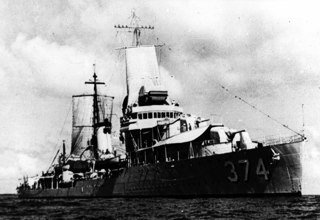
USS Tucker (DD 374), under sail.
The torpedo was the destroyer’s initial raison d’être. In 1864, Lt. William B. Cushing, USN attacked and sank the Confederate ironclad Albemarle from a small steam launch using an explosive device mounted on a long pole—a “spar torpedo”—which he detonated under water. Two years later in Austria, British engineer Robert Whitehead developed the first compressed air-propelled self-steering “automotive” torpedo, capable of perhaps 6–8 knots over 200–400 yards—the forerunner of the modern torpedo. Navies around the world quickly perceived the threat to the battle line that such a device would represent if delivered by a small, fast boat; before the end of the 19th century, many began building “torpedo boats” such as the US Navy’s Cushing class.
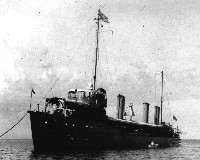
USS Bainbridge, Torpedo Boat Destroyer No. 1.
The United States was an emerging naval power as the 20th century began, operating not only off its own coasts but also from bases elsewhere around the world to protect its far-flung territories. To screen its fleet, it needed escorts fast and seaworthy enough to deal with the torpedo boat threat and also possessed of a large cruising radius.
The “torpedo boat destroyers” of the Bainbridge class mounted two torpedo tubes and two 3-inch guns. Commissioned in 1902, they were 400-ton coal-burners with reciprocating steam engines that occupied most of their internal spaces. Over the next fourteen years, the United States commissioned 68 such first-generation “destroyers,” which evolved in size and armament to 1,000-ton oil-fired steam turbine-driven ships—the navy’s new standard battle line escort and torpedo attack ships.
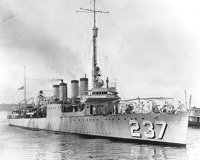
Second-generation destroyer USS McFarland (DD 237).
Just before it entered World War I, the US Navy began mass producing destroyers, eventually laying keels for 273 Caldwell-, Wickes- and Clemson-class “flush deckers.” These second-generation ships mounted twelve torpedo tubes, four 4-inch guns, a single 3-inch anti-aircraft gun and some light machine guns on a 1,190-ton, 314-foot hull. Only a few were placed in commission in time before the end of the war, but all were delivered by September 1922. Although they proved reliable in service, they lacked a large cruising radius and were much more numerous than the navy needed in peacetime, so more than half were soon mothballed while development funding was diverted elsewhere.
In 1922, a Conference on the Limitation of Armament produced a Treaty Between the United States of America, the British Empire, France, Italy, and Japan, which called for a freeze in the size and composition of major navies around the world, but did not regulate destroyers. With its continuing surplus of flush-deckers, the US abstained while all other signatory countries began building new, larger models. Japan, in particular, quickly developed its first “special type” destroyers, the Fubuki class of 1923, which displaced 1,750 tons on a 378-foot hull with six 5-inch guns and nine 24-inch torpedo tubes. These ships caught other navies by surprise when they began to appear in 1928 with their long, narrow hulls and extremely low silhouettes. Their 49-knot “Long Lance” torpedoes had an unsuspected 11-mile range and packed a 1,000-lb. warhead. With reserve torpedoes that could be reloaded during battle, they were the outstanding torpedo attack destroyers of the pre-radar era. By the beginning of World War II, Japan had 54 of them (110 destroyers total) in commission and more on the way.

Fubuki-class destroyer Amagiri.
With the design came technologies and tactics. While the US Navy declined to develop its poor torpedoes and actually removed them from its cruisers, Japanese destroyers and cruisers carried excellent torpedoes—reliable, fast, long-range and carrying a large explosive charge. As night fighting provides the greatest opportunity for success in short-range fighting where torpedoes can be most effective, the Japanese navy evolved excellent means of detection, including superior binoculars, and then drilled in night combat.
The Fubukis had a weakness. So much was packed into their long, narrow hulls that they tended to be top heavy. Even after modification, little margin was left for an increased anti-aircraft battery.
IJN Amagiri (“Misty Rain”), completed in 1930, was the 15th ship of the Fubuki class. She was the ship that Nicholas and Radford faced at Kula Gulf in the early morning of 6 July 1943. Four weeks later, on 2 August, she was also the ship that rammed and sank PT 109, Lt. John F. Kennedy commanding, and on 25 November, she was one of only two destroyers that escaped destruction by DesRon 23 at the Battle of Cape St. George. She was sunk by a mine south of Borneo 23 April 1944.
Meanwhile in 1930, a new naval arms limitation conference was convened in London. The resulting International Treaty for the Limitation and Reduction of Naval Armament defined total destroyer tonnage, established the two categories of destroyer and destroyer leader, and set the maximum tonnage of both categories and the allowable ratio of ships between them. As published in Ship’s Data for U.S. Naval Vessels, 1 July 1931, destroyers were defined as “surface vessels of war the Standard Displacement (S.D.) of which does not exceed 1,850 tons and with a gun not above 5.1-inch caliber.” While the “total completed tonnage not to be exceeded on December 31, 1936” was 150,000 tons S.D., however, “not more than 16 per cent of the allowed tonnage … shall be employed in vessels over 1,500 tons S.D.”
As these new, higher limits rendered the US’s 225 remaining four-stackers obsolete, the General Board moved quickly to begin replacing them. Considering Japan a likely adversary, it required ships that that could carry large quantities of fuel, supplies and ammunition far from home bases. The new designs also incorporated technological advances that, in some respects, leapfrogged those of other navies. Progress in naval aviation prompted the US (and also Japan) to consider a new dual-purpose main armament for anti-aircraft defense. The United States’ response was the 5-inch/38-caliber gun, which was powered and could fire rapidly enough to target aircraft. It was controlled by a central “director,” which could determine target range, direction, and speed and aim all guns by remote control, taking into account the course, speed, and motion of the ship. It became one of the finest weapons of its time.
Destroyer construction resumed in 1932, Over the next seven years, the US built several third-generation destroyer classes, collectively the “1,500-tonners,” all of which featured this new 5-inch gun on a 340-to-350-foot high-forecastle hull that could exceed 35 knots. With low freeboard aft, these were smart-looking ships—especially in their pre-war light gray.
Unfortunately, they were also top-heavy so weight-saving measures were required. In the two-stack Farragut (8 ships) and Mahan (18) classes, five 5-inch guns were initially attempted, but most of these were mounted without protection other than spray shields on the forward guns. Their instability soon caused the main batteries on these ships to be reduced to four guns. The following Gridley (4), Bagley (8), and Benham (10) classes were designed to carry only four 5-inch guns from the outset, while the torpedo battery was increased to eight tubes mounted in the waist on each side (sixteen total) and the boiler uptakes were trunked together into a single stack for an additional reduction in topside weight.
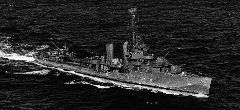
Third-generation destroyer USS Farragut (DD 348) as modified to reduce topweight.
Concurrently, the US built 1,850-ton leaders as permitted by treaty—eight Porter class (with two stacks) and five Somers class (with one stack). These also mounted 5-inch guns but in single-purpose twin mounts, with neither the elevation nor the ability to train rapidly enough for anti-aircraft defense.
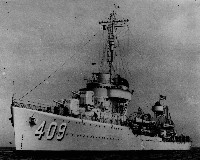
Third-generation destroyer
USS Sims (DD 409).
Superficially, the Sims class (12) looked more modern than the Benhams thanks to a streamlined pilothouse and rounded sheer strake forward—attempts to reduce windage—and they introduced the advanced Mk 37 gun director. As in the Farraguts, twelve torpedo tubes and five 5-inch guns were again attemped.
The fourth-generation Benson (30) and the concurrently-designed Gleaves (66, also known as the Livermore) classes were similar in appearance to the Sims class, but returned to a two-stack layout, reflecting a “split” powerplant, in which two fire rooms alternated with two engine rooms for improved survivablity in case of a torpedo hit.
In all these classes, however, stability problems persisted. Solutions for reduced topweight ranged from the reduction of one 5-inch mount (Farragut, Porter, Mahan, Somers, Sims, Benson and Gleaves classes) and the substitution of canvas-topped gunhouses to the removal of anchors and other equipment. Beginning with Bristol (DD 453), all new construction reverted to four 5-inchers.
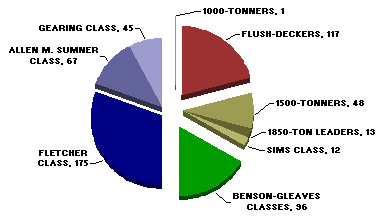
US Navy destroyers and conversions in commission during World War II, 7 December 1941–2 September 1945: 287 “big” (i.e., more than 2,000-ton) Fletcher-, Allen M. Sumner- and Gearing-class destroyers and 287 ships of earlier classes.
But something bigger and more balanced was on the way. In late 1939, after war broke out in Europe, the US Navy had begun evaluating sketches for a five-gun ship that could meet all its requirements without stability problems—its first destroyer design since World War I unconstrained by treaty limitations. Because of both their sheer numbers and their advanced design, the 175 ships of this new 2,100-ton Fletcher class soon emerged as the standard fleet destroyers of the Pacific war. These were joined before the war ended by 112 ships of derivative design—67 Allen M. Sumner-class 2,200-tonners, mounting six 5-inch guns in three twin gunhouses on a slightly widened hull, and 45 Gearing-class “long hull” 2,200-tonners on a slightly lengthened one. Collectively, these “big” destroyers emerged as the most successful destroyer designs of World War II.
References: Dull, Friedman, Reilly, Roscoe, Sumrall, Weymouth Diving.